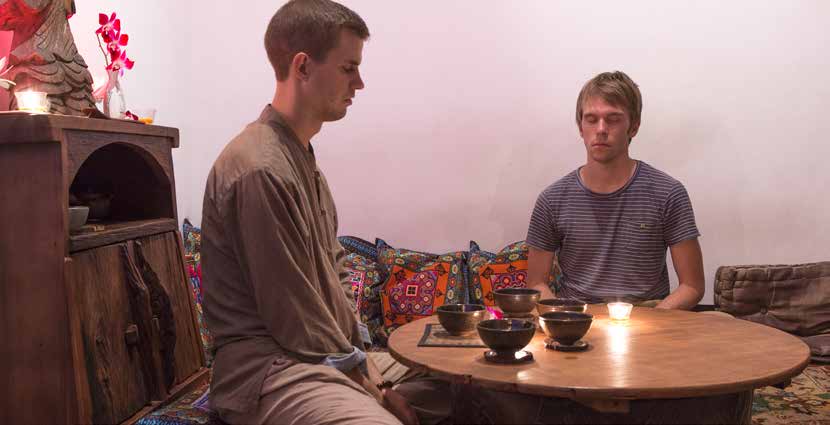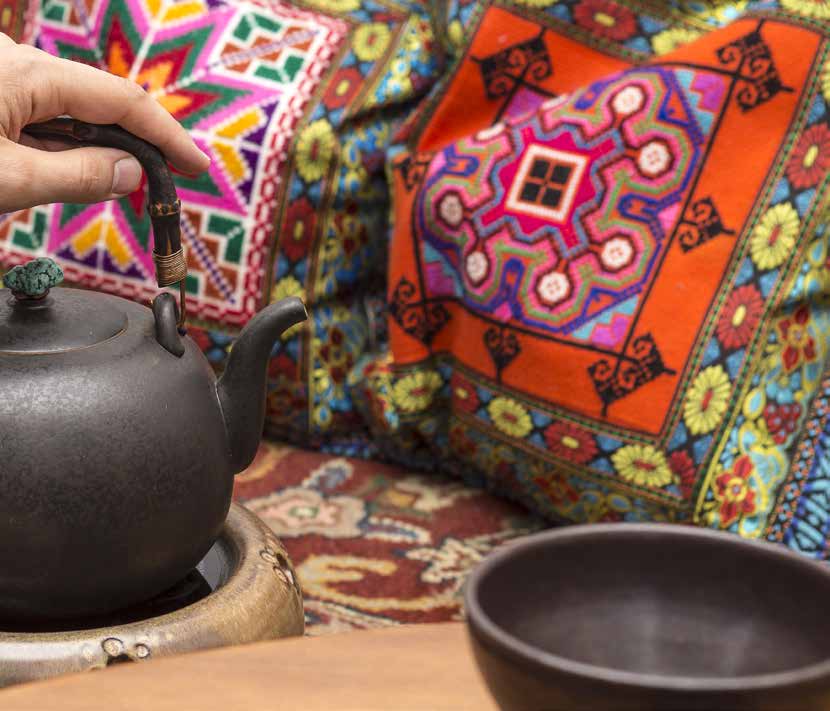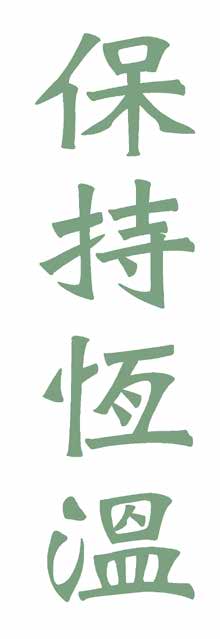
 |
|

Last month we focused on the importance of heat in tea brewing. There are so many aspects to that, and so many experiments that you can do to recognize the difference a little heat brings to tea brewing. We did one involving a preheated and regular cup, focusing on the difference preheating the cup brings to the tea liquor. Hopefully, you noticed that the pre-heated cup was very different. There are many other experiments that we have covered over the years that deal with heat in gongfu tea. If you are new to Global Tea Hut, you may want to look through some past issues on our website and try out some of the other experiments we've offered, like showering the pot, preheating the pot, etc. - all of which help you to develop a deeper appreciation for the role fire plays in gongfu tea.
In our tradition, the practice and way of gongfu tea is preserved in a poem:
Preserve the heat and begin to absorb peace, With slow, gentle and graceful movements, And a heart free of obstructions, Everything is finished in one breath.
Over the coming months, we thought we could discuss this poem a bit, line by line, starting with the first. There is a lot to unpack, and though we've practiced and worked with this poem for years, we haven't yet found a bottom. It is a treasure trove of deep and lasting teachings, from how to pour gongfu tea to how to live. Last month we discussed the "preserve the heat" part of the poem. This month we would like to delve into "begin to absorb peace".
Since ancient times, boiling water for Tea has always been a period for meditation. They say that the sound the water makes when it begins to boil is "the wind soughing the pines" and many old poems have lines like, "The wind soughing the pines summoned me back from my meditation". This means that the water started boiling, bringing the mind back from introspection to the beginning of tea. We always teach students that they should never lift the kettle until the heart is at peace. It is so rewarding to take the time to begin to absorb some peace as the water boils. If your heart is not at peace, you will never properly brew tea. And if you are going to have a conversation over tea, a bit of silence at the beginning will make your time spent with friends and loved ones so much more rewarding.
By absorbing the peace of this moment, without anything else to do but enjoy some tea, we let go of our problems and worries. Nothing can serve the coming tea preparation as much as that. If we start with a peaceful mind, we ensure that our movements will be graceful, we protect our teaware and ensure that we'll prepare the tea in the best way we can. Of course, we will make mistakes along the way.
Here are a few little tips about how to avoid an over-boiling kettle of water. We've all had the situation where our kettle suddenly comes to a full boil and sputters and spurts all over our burner in the middle of a tea session. Sure, the Zen of "anything goes" always conveniently rules, right? But at the same time, if the goal is smooth, gongfu tea service, then this is far from ideal.
Eyes sometimes fly open at the distraction, and attention has for sure been taken from whatever moment our guests were experiencing. Even if it is just for a few seconds, and even if this does certainly not ruin the session, it is not ideal. If a ballet dancer trips on stage during a performance, it doesn't ruin the evening and life goes on quite happily - but it wasn't mastery. Skill was missing and, above all, grace and fluidity were interrupted. And, the human brain being highly attuned to noticing everything wrong in a situation, this bit will be remembered.
So, how can we avoid this?
The short answer is the same as for anything: awareness - calm, focused awareness. And the longer answer is: get to know your teaware intimately so that you are fine-tuned to it... And don't worry about your finger tips! Wu De always suggests that beginners occasionally tap hot teaware or put their hands into the teaboat and feel the hot water. Of course, this is within reason - don't burn yourself. The idea is to get used to some heat so you don't drop a lid or pot if it is hot.

Since ancient times, boiling water for Tea has always been a period for meditation.
Before I go on, some of you might be wondering: there is one way to see if the water is boiling that is so obvious and simple, so why do we need to write so much about it? You may be thinking: "Want to know if the water is about to boil? Well then check if the water is about to boil! Just lift the lid and see!" But I'd say that should be a last resort. Not horrible, but not ideal. Again, it causes people's attention to be distracted, even if slightly. It also takes your attention away from the service and the guests. It also is likely to cause some clanking as the lid is taken off and placed back. The act itself is often not beautiful (though it can be done gracefully too): removing the lid, peering over the pot and moving your head back and forth to get a better view through the steam, squinting, placing the lid back... The problem with this method is that it keeps you reliant on this method in the future and actually doesn't really tell you when boiling will happen if you are not familiar with the boiling process. You may have to open the lid two or three times to keep checking - it's clunky, distracting, uneven, and un-poetic.

My method of choice is touch. Use your fingertips and place them on a chosen spot on the kettle (my favorite spot is at the top of the kettle body, just away from the lid) and after a while, you get to know very precisely the intensity of the heat (measured in how long you can keep your fingers on it before you need to remove them). This requires getting to know your kettle well, as each one will have a slightly different texture and 'heat feel'. It is also subtle, silent and unobtrusive. No one pays attention to this, and the session proceeds gracefully. It also sharpens your sensitivity! Depending on the kettle, you can also grab the handle and feel the vibrations. Each different degree of heat has a different vibration and feel, and as you get to know the kettle this method will also be reliable.

Other good methods involve two of the other senses: visually assess the boiling point by the presence and speed of steam emerging from the spout, or through your gorgeous ears by the sound the kettle makes. These are also skillful, non-disruptive means. You'll notice, for example, that when steam emerges in a steady stream from the spout but not much from the hole in the lid, the water is basically boiling with small bubbles beginning to break the surface. Once the steam is pushing out forcibly from the hole in the lid, it's boiling too aggressively already. Also, sound-wise, you will notice in many (not all) kettles a steadily increasing sound as the water gets hot, then a sudden, little lull (drop in sound). That's your cue to keep a careful watch; it has just got hot enough to use and is soon about to boil.
Your experiment for this month is to try a few tea sessions in which you practice more "absorbing peace" as the water heats up. Try getting to know your kettle through your senses, rather than disturbing the session by repeatedly lifting the lid. Compare these sessions to the others in which you didn't meditate while the water was boiling. How were they different? How was the tea itself affected? Did it taste different? Feel different?
By attuning yourself to the peace that is this space, you will definitely serve an improved brew. But like all gongfu tea tips, this one has to be experienced...

